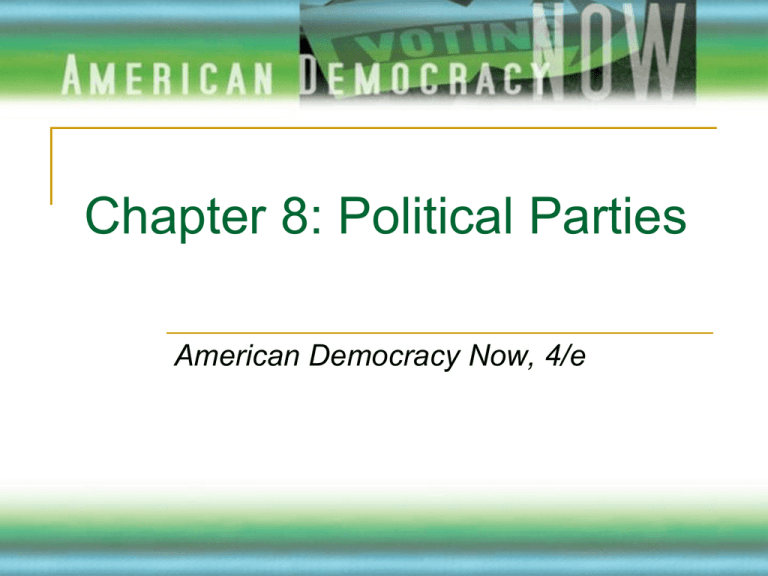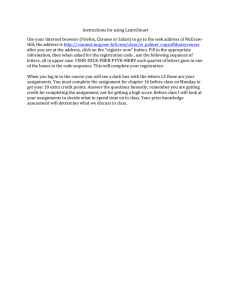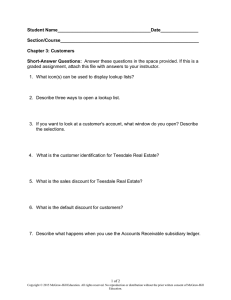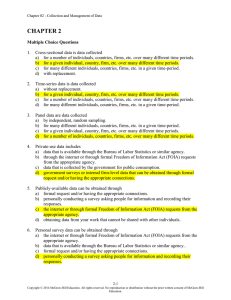
Chapter 8: Political Parties
American Democracy Now, 4/e
Are Political Parties Today in Crisis?
A political party is an organization of
ideologically similar people that nominates and
elects its members to office in order to run the
government and shape public policy.
Parties identify potential candidates, nominate
them to run for office, campaign for them,
organize elections, and govern.
Copyright © 2015 McGraw-Hill Education. All rights reserved. No
reproduction or distribution without the prior written consent of McGrawHill Education.
Are Political Parties Today in Crisis?
In recent years, both parties have struggled to
win the approval of the American people.
Increased polarization of the two parties
One-party dominance in districts facilitates
election of extremely ideological candidates
Tea Party movement and the Republican Party
October 2013: 16-day shutdown of government
Copyright © 2015 McGraw-Hill Education. All rights reserved. No
reproduction or distribution without the prior written consent of McGrawHill Education.
Copyright © 2015 McGraw-Hill Education. All rights reserved. No
reproduction or distribution without the prior written consent of
McGraw-Hill Education.
Parties Today and Their Functions
1.
2.
3.
4.
Political parties run candidates under their own
label, or affiliation.
Political parties seek to govern.
Political parties have broad concerns, focused
on many issues.
Political parties are quasi-public organizations
that have a special relationship with the
government.
Copyright © 2015 McGraw-Hill Education. All rights reserved. No
reproduction or distribution without the prior written consent of McGrawHill Education.
How Parties Engage Individuals
Political parties represent one of the main
channels through which citizens can make
their voices heard.
A fixture in the politics of American
communities large and small, parties today
are accessible to virtually everyone.
Copyright © 2015 McGraw-Hill Education. All rights reserved. No
reproduction or distribution without the prior written consent of McGrawHill Education.
What Political Parties Do
Parties provide a structure for people at the grassroots
level to volunteer on party-run campaigns, make
campaign contributions, work in the day-to-day
operations of the party, and run for office.
Political parties foster cooperation between divided
interests and factions, building coalitions even in the
most divisive of times.
Political parties also grease the wheels of government
and ensure its smooth running.
Copyright © 2015 McGraw-Hill Education. All rights reserved. No
reproduction or distribution without the prior written consent of McGrawHill Education.
What Political Parties Do
By serving as a training ground for members, political
parties also foster effective government.
Political parties promote civic responsibility among
elected officials and give voters an important “check” on
those elected officials.
The responsible party model posits that a party tries to
give voters a clear choice by establishing priorities or
policy stances different from those of the rival party or
parties.
Copyright © 2015 McGraw-Hill Education. All rights reserved. No
reproduction or distribution without the prior written consent of McGrawHill Education.
The Three Faces of Parties
The three components of the party include
1.
2.
3.
The party in the electorate
The party organization
The party in government
Copyright © 2015 McGraw-Hill Education. All rights reserved. No
reproduction or distribution without the prior written consent of McGrawHill Education.
Copyright © 2015 McGraw-Hill Education. All rights reserved. No
reproduction or distribution without the prior written consent of
McGraw-Hill Education.
The Party in the Electorate: Measuring the
Party in the Electorate
The term party identifier refers to an individual
who identifies himself or herself as a member of
one party or the other; party identifiers typically
are measured by party registration.
An independent is a voter who does not belong
to any organized political party; often used as a
synonym for an unaffiliated voter.
The party in the electorate also includes those
individuals who express a tendency to vote for
one party or a preference for that party.
Copyright © 2015 McGraw-Hill Education. All rights reserved. No
reproduction or distribution without the prior written consent of McGrawHill Education.
The Party in the Electorate: Determining
Who Belongs to Each Political Party
Whites, men, people with some college
education, upper middle class, and
conservatives are more likely to be Republicans.
For the Democrats, key voting blocs include
African Americans, Hispanics, working class,
women, liberals, and people with no college
education.
Copyright © 2015 McGraw-Hill Education. All rights reserved. No
reproduction or distribution without the prior written consent of McGrawHill Education.
The Party in the Electorate: Differences
Between Democrats and Republicans
The Democratic agenda includes: civil rights,
support for social welfare programs, gay rights,
environmental protection, and freedom of choice
with respect to abortion.
Traditionally, Republicans have countered that
position by advocating a smaller government
that performs fewer social welfare functions.
But a major priority for the Republican Party
today is advocacy of a stronger governmental
role in regulating traditional moral values.
Copyright © 2015 McGraw-Hill Education. All rights reserved. No
reproduction or distribution without the prior written consent of McGrawHill Education.
Political Parties
Where Do You Stand?
In your opinion, which major U.S. political party does a
better job of ensuring a healthy economy?
a. Republican Party
b. Democratic Party
c. Neither party
d. No opinion
Source: “Party Images,” www.gallup.com/poll/24655/Party-Images.aspx.
Copyright © 2015 McGraw-Hill Education. All rights reserved. No
reproduction or distribution without the prior written consent of McGrawHill Education.
The Party Organization
Party organization refers to the formal party apparatus,
including committees, headquarters, conventions, party
leaders, staff, and volunteer workers.
Theoretically, parties’ organization resembles a pyramid.
In reality, the national committees of both major U.S.
political parties exist separately from the committees of
the state and local parties (and real political power can
usually be found at the local or county party level).
Copyright © 2015 McGraw-Hill Education. All rights reserved. No
reproduction or distribution without the prior written consent of McGrawHill Education.
Copyright © 2015 McGraw-Hill Education. All rights reserved. No
reproduction or distribution without the prior written consent of
McGraw-Hill Education.
Copyright © 2015 McGraw-Hill Education. All rights reserved. No
reproduction or distribution without the prior written consent of
McGraw-Hill Education.
The National Parties
Every four years, political party activists meet at
a national convention to determine their party’s
nominee for the presidency.
The national party committees are the national
party organizations charged with conducting the
conventions and overseeing the operation of the
national party during the interim between
conventions.
Copyright © 2015 McGraw-Hill Education. All rights reserved. No
reproduction or distribution without the prior written consent of McGrawHill Education.
The National Parties
The national committee elects a national chair.
The national chair, along with the paid staff of
the national committee, oversees the day-to-day
operations of the political party.
One of the most important roles of the national
chair has been to raise funds.
Copyright © 2015 McGraw-Hill Education. All rights reserved. No
reproduction or distribution without the prior written consent of McGrawHill Education.
State Parties
Both national parties have committees in each
state that effectively are the party in that state.
State committees act as intermediaries between
the national committees and county committees.
Typically, state committees are made up of a
few members from each county or other
geographical subdivision of a given state.
Copyright © 2015 McGraw-Hill Education. All rights reserved. No
reproduction or distribution without the prior written consent of McGrawHill Education.
County and Local Parties
County committees consist of members of
municipal, ward, and precinct party committees.
County committees help recruit candidates for
office, raise campaign funds, and mobilize
voters.
In most major cities, ward committees and
precinct committees dominate party politics.
Copyright © 2015 McGraw-Hill Education. All rights reserved. No
reproduction or distribution without the prior written consent of McGrawHill Education.
The Party in Government
The party in government—the partisan
identification of elected leaders in local, county,
state, and national government—significantly
influences the organization and running of the
government at these various levels.
Copyright © 2015 McGraw-Hill Education. All rights reserved. No
reproduction or distribution without the prior written consent of McGrawHill Education.
Copyright © 2015 McGraw-Hill Education. All rights reserved. No
reproduction or distribution without the prior written consent of
McGraw-Hill Education.
Divided Government
When Republicans won control of the U.S. House of
Representatives in 2010, President Obama faced
truncated government, when one chamber of
Congress is controlled by the same party that controls
the White House, while the other chamber is controlled
by the other party.
During parts of the Bill Clinton and George W. Bush
administrations, the president and the members of
Congress functioned with a divided government, the
situation in which one party controls both houses of
Congress and the other party, the presidency.
Copyright © 2015 McGraw-Hill Education. All rights reserved. No
reproduction or distribution without the prior written consent of McGrawHill Education.
Political Parties in U.S. History
Party system refers to the number and
competitiveness of political parties in a polity.
The demarcation of party systems typically
occurs when social scientists recognize points
where there has been realignment, a shift in
party allegiances or electoral support.
Copyright © 2015 McGraw-Hill Education. All rights reserved. No
reproduction or distribution without the prior written consent of McGrawHill Education.
The First Party System: The Development
of Parties, 1789-1828
In 1788, George Washington was elected
president, but the consensus surrounding his
election proved short-lived.
Hamilton & the Federalists favored strong
national government.
Opposed by Jefferson who feared strong
national government.
The 1796 and 1800 elections
Copyright © 2015 McGraw-Hill Education. All rights reserved. No
reproduction or distribution without the prior written consent of McGrawHill Education.
The First Party System: The Development
of Parties, 1789-1828
The 1800 election marked end of Federalists.
The supporters of Jefferson became known as
Jeffersonian Republicans; later, DemocraticRepublicans. The modern descendants of the
Democratic-Republicans today are called
Democrats.
The Era of Good Feelings (1815-1828)
Copyright © 2015 McGraw-Hill Education. All rights reserved. No
reproduction or distribution without the prior written consent of McGrawHill Education.
The Second Party System: The
Democrats’ Rise to Power, 1828-1860
The Jacksonian Democrats. They espoused populism
and the spoils system.
The Jacksonian Democrats succeeded in mobilizing the
masses, sweeping Jackson to victory in the presidential
election of 1828.
Whig party founded in 1836 to represent interests of
southern plantation owners and northern industrialists.
Political parties had become the medium through which
many Americans were politicized, and in 1828, for the
first time, more than one million Americans cast their
ballots in the presidential contest.
Copyright © 2015 McGraw-Hill Education. All rights reserved. No
reproduction or distribution without the prior written consent of McGrawHill Education.
The Third Party System: The Republicans’
Rise to Power, 1860-1896
In the 1850s, slavery became the primary
concern for both the Whigs and the Democrats.
A new antislavery party, the Republicans,
formed in 1854 and gained the support of
abolitionist Whigs and northern Democrats.
The victory of the Republican presidential
nominee, Abraham Lincoln, in the election of
1860 marked the beginning of a period of
dominance of the antislavery Republicans,
which continued even after the Civil War.
Copyright © 2015 McGraw-Hill Education. All rights reserved. No
reproduction or distribution without the prior written consent of McGrawHill Education.
The Third Party System: The Republicans’
Rise to Power, 1860-1896
During this time, the Republican Party enjoyed
strong support from newly franchised AfricanAmerican voters.
Political machines came to dominate the
political landscape during this period.
Party bosses & patronage system
Copyright © 2015 McGraw-Hill Education. All rights reserved. No
reproduction or distribution without the prior written consent of McGrawHill Education.
The Fourth Party System: Republican
Dominance, 1896-1932
The 1896 election ushered in an era of Republican
dominance that would last until the election of 1912.
In the 1912 presidential election, Theodore Roosevelt
ran as a Progressive.
The Republicans’ split between William Howard Taft’s
regular Republicans and Roosevelt’s Progressives
powered Democrat Woodrow Wilson to the presidency
with only 42 percent of the popular vote.
Progressive reforms during Wilson presidency.
After Wilson’s two terms, the Republicans retained
control of the presidency throughout the 1920s.
Copyright © 2015 McGraw-Hill Education. All rights reserved. No
reproduction or distribution without the prior written consent of McGrawHill Education.
The Fifth Party System: Democratic
Dominance, 1932-1968
Franklin D Roosevelt (FDR) elected in the 1932 election.
FDR promoted a New Deal, a broad program in which
the government would bear the responsibility of
providing a “safety net” to protect the most
disadvantaged members of society.
FDR supported by New Deal coalition—a voting bloc
comprising traditional southern Democrats, northern city
dwellers (especially immigrants and the poor), Catholics,
unionized and blue-collar workers, African Americans,
and women.
Copyright © 2015 McGraw-Hill Education. All rights reserved. No
reproduction or distribution without the prior written consent of McGrawHill Education.
The Fifth Party System: Democratic
Dominance, 1932-1968
Truman (1948) and Eisenhower (1952 & 1956)
election victories
Although Democrats John F. Kennedy and
Lyndon Johnson held the presidency through
most of the 1960s, the events of that decade
wreaked havoc on the Democratic Party, with
deep divisions opening up over the Vietnam War
and civil rights for African Americans.
Copyright © 2015 McGraw-Hill Education. All rights reserved. No
reproduction or distribution without the prior written consent of McGrawHill Education.
A New Party System?
Political scientists have sought to determine whether the
era that began in 1968 can be considered a separate
party system.
Republican dominance of the presidency since 1968,
coupled with increasing support of the Republican Party
by southern whites and the increasing activism of
conservative Christians in the party, gives support to the
claim that a new party system has emerged.
Additional characteristics of this new party system,
according to scholars, include intense party competition
and divided government.
Copyright © 2015 McGraw-Hill Education. All rights reserved. No
reproduction or distribution without the prior written consent of McGrawHill Education.
The Party System Today: In Decline,
in Resurgence, or a Post-Party Era?
Given the various historical changes to the U.S.
political party system, many political scientists
have inquired into what the impact of those
changes will be.
Do the changes signify an end to party control in
American politics?
Or can political parties adapt to the altered
environment and find new sources of power?
Or are we entering a post-party era?
Copyright © 2015 McGraw-Hill Education. All rights reserved. No
reproduction or distribution without the prior written consent of McGrawHill Education.
The Party’s Over
Some argue that the elimination of political
patronage through the requirement of civil
service qualifications for government employees
has significantly hurt parties’ ability to reward
loyal followers with government jobs.
Other political scientists emphasize the
government’s increased role over time in
providing social welfare benefits as a contributor
to the decline of political parties.
Copyright © 2015 McGraw-Hill Education. All rights reserved. No
reproduction or distribution without the prior written consent of McGrawHill Education.
The Party’s Over
Primary elections have decreased parties’
power by taking the control of nominations from
party leaders and handing it to voters.
Changes in the mass media have also meant a
drastically decreased role for political parties.
The rise in candidate-centered campaigns has
also weakened political parties.
Copyright © 2015 McGraw-Hill Education. All rights reserved. No
reproduction or distribution without the prior written consent of McGrawHill Education.
The Party’s Just Begun
According to this view, the parties’ ability to
rebound is alive and well.
These scholars argue that the continued
dominance in the United States of two political
parties—through decades of threats to their
survival—has demonstrated a strength and a
resilience that are likely to prevail.
Scholars also cite the lack of viable alternatives
to the two-party system.
Copyright © 2015 McGraw-Hill Education. All rights reserved. No
reproduction or distribution without the prior written consent of McGrawHill Education.
A Post-Party Era?
Some scholars see dealignment and ticket
splitting as notable characteristics of this new
party system.
The period since 1968 has also been
characterized by the growing importance of
candidate-centered politics, including the
importance of candidate committees.
Copyright © 2015 McGraw-Hill Education. All rights reserved. No
reproduction or distribution without the prior written consent of McGrawHill Education.
Two-Party Domination in U.S. Politics
Since the ratification of the Constitution in 1787,
the United States has had a two-party system for
all but about 30 years.
A third party is a political party organized as
opposition or an alternative to the existing
parties in a two-party system.
Copyright © 2015 McGraw-Hill Education. All rights reserved. No
reproduction or distribution without the prior written consent of McGrawHill Education.
The Dualist Nature of Most Conflicts
Historically, many issues in the United States
have been dualist, or “two-sided.”
Political scientists Seymour Martin Lipset and
Stein Rokkan asserted that the dualist nature of
voter alignments or cleavages shapes how
political parties form.
Copyright © 2015 McGraw-Hill Education. All rights reserved. No
reproduction or distribution without the prior written consent of McGrawHill Education.
The Winner-Take-All
Electoral System
In almost all U.S. elections, the person with the
most votes wins.
Compare the winner-take-all system with the
proportional representation system found in
many nations.
In a proportional representation system,
political parties win the number of parliamentary
seats equal to the percentage of the vote each
party receives.
Copyright © 2015 McGraw-Hill Education. All rights reserved. No
reproduction or distribution without the prior written consent of McGrawHill Education.
Continued Socialization to the
Two-Party System
Party identification—like ideology, values, and
religious beliefs—is an attribute that often
passes down from one generation to the next.
Copyright © 2015 McGraw-Hill Education. All rights reserved. No
reproduction or distribution without the prior written consent of McGrawHill Education.
Election Laws That Favor
the Two-Party System
At both the federal and the state level in the
United States, election laws benefit the two
major parties because they are usually written
by members of one or both of those parties.
Copyright © 2015 McGraw-Hill Education. All rights reserved. No
reproduction or distribution without the prior written consent of McGrawHill Education.
Third Parties in the United States
Because of the differing ideological viewpoints of
those who agree a third party is needed, third
parties have had little success in contesting
elections.
One of the most significant obstacles to the
formation of a viable third party is that people
who are dissatisfied with the two dominant
parties fall across the ideological spectrum.
Copyright © 2015 McGraw-Hill Education. All rights reserved. No
reproduction or distribution without the prior written consent of McGrawHill Education.
Third Parties in the United States
Third parties are particularly effective at
encouraging the civic engagement of people
who feel that the two dominant parties do not
represent their views or do not listen to them.
In recent years, we have seen this role played
by the Tea Party, which has channeled the
participation of many conservatives frustrated
with the two major political parties.
Copyright © 2015 McGraw-Hill Education. All rights reserved. No
reproduction or distribution without the prior written consent of McGrawHill Education.
Majorities Support a Third Major Party
Across the Ideological Spectrum
Copyright © 2015 McGraw-Hill Education. All rights reserved. No
reproduction or distribution without the prior written consent of McGrawHill Education.
Types of Third Parties:
Issue Advocacy Parties
Formed to promote a stance on a particular
issue, many issue advocacy parties are shortlived.
Once the issue is dealt with or fades from
popular concern, the mobilizing force behind the
party disintegrates.
Copyright © 2015 McGraw-Hill Education. All rights reserved. No
reproduction or distribution without the prior written consent of McGrawHill Education.
Types of Third Parties:
Ideologically Oriented Parties
The agenda of an ideologically oriented party is
typically broader than that of an issue-oriented
party.
Examples include the Libertarian and Socialist
parties.
Copyright © 2015 McGraw-Hill Education. All rights reserved. No
reproduction or distribution without the prior written consent of McGrawHill Education.
Types of Third Parties:
Splinter Parties
A splinter party is a political party that breaks off,
or “splinters,” from one of the two dominant
parties.
In 1948, a group of southern Democrats who
opposed the Democratic Party’s support of civil
rights for African Americans splintered from the
Democratic Party to form the States’ Rights
Party, also known as the Dixiecrat Party.
Copyright © 2015 McGraw-Hill Education. All rights reserved. No
reproduction or distribution without the prior written consent of McGrawHill Education.
The Impact of Third Parties
Although U.S. third parties usually do not win
elections, they can influence electoral outcomes.
For example, given the closeness of the 2000
presidential race, many Democrats believe that
Green Party candidate Ralph Nader caused
Democrat Al Gore to lose the election.
Third parties provide a release valve for
dissatisfied voters.
Third parties put a variety of issues on the
national political
agenda.
Copyright © 2015 McGraw-Hill Education. All rights reserved. No
reproduction or distribution without the prior written consent of McGrawHill Education.
Copyright © 2015 McGraw-Hill Education. All rights reserved. No
reproduction or distribution without the prior written consent of
McGraw-Hill Education.
Political Parties
Where Do You Stand?
Do you think the Republican and Democratic parties
represent the interests of the American people
effectively, or do we need a third major party?
a. They do an effective job.
b. We need a third major party.
c. No opinion
Source: “Party Images,” www.gallup.com/poll/24655/Party-Images.aspx.
Copyright © 2015 McGraw-Hill Education. All rights reserved. No
reproduction or distribution without the prior written consent of McGrawHill Education.
New Ideologies, New Technologies:
The Parties in the Twenty-First Century
American political parties have changed
dramatically in recent years. Global events such
as the end of the Cold War, international and
domestic terrorism, a multifront war, and the
impact of the Internet and cellular technologies
have partly driven the changes.
Copyright © 2015 McGraw-Hill Education. All rights reserved. No
reproduction or distribution without the prior written consent of McGrawHill Education.
A Battle for the Soul
of the Republican Party Today
1.
2.
3.
4.
5.
Tea Partiers have identified five key
principles they believe:
less government
fiscal responsibility
lower taxes
states’ rights
national security
Copyright © 2015 McGraw-Hill Education. All rights reserved. No
reproduction or distribution without the prior written consent of McGrawHill Education.
Democrats Today
When it comes to issues and policy priorities,
today’s Democrats, under Obama’s leadership,
more resemble the Democrats of the midtwentieth century: a party that emphasized a
strong role of government.
There also is an emphasis and a sophistication
when it comes to maximizing the use of new
technologies in politics.
Copyright © 2015 McGraw-Hill Education. All rights reserved. No
reproduction or distribution without the prior written consent of McGrawHill Education.
Changing Both Parties: New Technologies
Today more and more people in the electorate
are finding information about issues on the
Internet and via their cell phones.
Parties are increasingly using new technologies
as tools for reaching loyalists and
communicating with potential supporters.
Copyright © 2015 McGraw-Hill Education. All rights reserved. No
reproduction or distribution without the prior written consent of McGrawHill Education.






